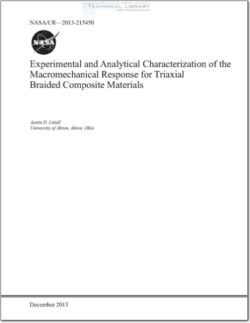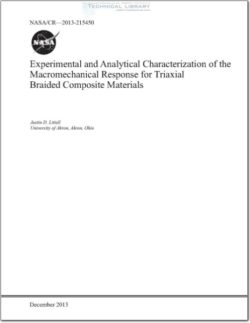NASA-CR-2013-215450

- Version
- 242 Downloads
- 20.27 MB File Size
- 1 File Count
- April 19, 2016 Create Date
- April 19, 2016 Last Updated
Experimental and Analytical Characterization of the Macromechanical Response for Triaxial Braided Composite Materials

Summary
Increasingly, carbon composite structures are being used in aerospace applications. Their high-
strength, high—stiffness, and low—weight properties make them good candidates for replacing many
aerospace structures currently made of aluminum or steel. Recently, many of the aircraft engine
manufacturers have developed new commercial jet engines that will use composite fan cases. Instead of
using traditional composite layup techniques, these new fan cases will use a triaxially braided pattern,
which improves case performance. The impact characteristics of composite materials for jet engine fan
case applications have been an important research topic because Federal regulations require that an engine
case be able to contain a blade and blade fragments during an engine blade—out event. Once the impact
characteristics of these triaxial braided materials become known, computer models can be developed to
simulate a jet engine blade-out event, thus reducing cost and time in the development of these composite
jet engine cases. The two main problems that have arisen in this area of research are that the properties for
these materials have not been fully determined and computationally efficient computer models, which
incorporate much of the microscale deformation and failure mechanisms, are not available.
The research reported herein addresses some of the deficiencies present in previous research
regarding these triaxial braided composite materials. The current research develops new techniques to
accurately quantify the material properties of the triaXial braided composite materials. New test methods
are developed for the polymer resin composite constituent and representative composite coupons. These
methods expand previous research by using novel specimen designs along with using a noncontact
measuring system that is also capable of identifying and quantifying many of the microscale failure
mechanisms present in the materials. Finally, using the data gathered, a new hybrid micro-
macromechanical computer model is created to simulate the behavior of these composite material systems
under static and ballistic impact loading using the test data acquired. The model also quantifies the way in
which the fiber/matrix interface affects material response under static and impact loading.
The results show that the test methods are capable of accurately quantifying the polymer resin under a
variety of strain rates and temperature for three loading conditions. The resin strength and stiffness data
show a clear rate and temperature dependence. The data also show the hydrostatic stress effects and
hysteresis, all of which can be used by researchers developing composite constitutive models for the
resins. The results for the composite data reveal noticeable differences in strength, failure strain, and
stiffness in the different material systems presented. The investigations into the microscale failure
mechanisms provide information about the nature of the different material system behaviors. Finally, the
developed computer model predicts composite static strength and stiffness to within 10 percent of the
gathered test data and also agrees with composite impact data, where available.
1.0 Introduction
Increasingly, carbon composite structures are being used in aerospace applications. Their high-
strength, high-stiffness, and low-weight properties make them good candidates for replacing many
aerospace structures currently made of aluminum or steel. As reported by Boeing, 50 percent of the
new 787 “Dreamliner” commercial wide—body passenger jet consists of composite materials (Ref. 1).
NASA/CR72013-215450 l
The new 787 is also using General Electric’s (GE’s) new GENx turbofan engine. Both the blade and the
engine case in this new GENx turbofan engine are made of composite materials. Similarly, other jet
engine manufacturers such as Williams International, Honeywell Aerospace, and Rolls—Royce, are
developing their own composite engine cases. GE’s new GENx is a case already in production whereas
Williams Intemational’s F J44—3 and Honeywell’s HTF7000 are demonstration cases currently in the
design and testing stages. However, instead of being made with traditional unidirectional composite
layups, these new fan cases are using a two—dimensional, triaxial braided composite architecture.
A major concern for these companies is that the design of a jet engine case has to have the ability to
contain a fan blade in the event that an engine blade-out event occurs. Federal Aviation Administration
(FAA) Regulation, FAR Part 33 Section 947Blade Containment and Rotor Unbalance Tests, requires that
the engine case contain a fan blade released at full engine operating speed (Ref. 2). In an engine blade—out
event, a fan blade becomes dislodged from the engine center hub and strikes the side of the engine case at
a high velocity while the engine is at full operating speed. For composite engine cases, there are two main
types of designs for containing engine blades, and these cases fall into either the hardwall or softwall
category. An engine case with a hardwall design has sufficient wall thickness around the impact areas to
allow the structure itself to resist the penetration and absorb the energy from a released blade. An engine
case with a softwall design has an outer layer of Kevlar (DuPont) or Zylon (Toyobo Co., Ltd.) wrapped
around the engine case in the most critical area of penetration. For softwall containment, the engine case
is designed to allow the blade to penetrate the inner structure, which absorbs the majority of the blade
energy, but the ultimate containment is accomplished by the outer wrap (Ref. 3). In both designs, engine
case materials must provide sufficient impact resistance to prevent penetration by a titanium or composite
fan blade operating at speeds in the range of 600 to 1000 ft/s (183 to 305 m/s).
To pass these requirements, engine manufacturers must conduct destructive blade-out tests on
operating engines. Because full-scale and subscale testing of aircraft engines during blade—out conditions
is expensive and time consuming and because data are difficult to obtain, alternative methods for
evaluating case designs are needed. Accurate computer models that simulate an engine blade-out test
offer one attractive alternative for examining the dynamics of the system and diagnosing potential failure
mechanisms that occur in a full-scale test. For these reasons, computer models can be used as analysis
tools to complement testing where necessary. Once accurate models are developed, system parameters,
such as blade speed and trajectory, material systems, and engine case geometry, can be changed with
relative ease without having to rerun a full-scale test. Although computer models cannot replace full—scale
testing, they can serve as tools to identify and mitigate potential problems before they arise in a full—scale
test. However, developing accurate computer models for simulation requires understanding the details of
the composite material systems in question.
Carbon-fiber—reinforced composites offer weight savings in aircraft design while still maintaining a
high strength-to-weight ratio. Material systems currently being examined for use in composite engine
cases are two-dimensional triaxial braided carbon-fiber composites, which offer higher impact resistance
than traditional unidirectional composite laminates. Because of these characteristics, the triaxial braided
carbon-fiber materials are ideal for the hardwall engine case design.
Traditional composite structures have stacked layers of unidirectional fiber lamina s to form the
composite laminate. However, in two-dimensional triaxial braided carbon-fiber—composite material
systems, each lamina layer consists of two sets of fiber bundles braided at $60 angles, which undulate
over and under a 00 axial fiber. This alternating pattern of +®°, 0°, and —®° fibers provides the distinct
braid pattern, and because each lamina layer has all three orientations of fiber bundles, material
characteristics such as impact strength and delamination resistance are improved.
In carbon-fiber polymer matrix composites, the carbon-fiber tows provide the stiffness and strength
when the composite is loaded longitudinally to the fiber direction, whereas the polymer matrix binds the
fibers together and provides much of the strength transverse to the fiber direction. The properties of the
polymer matrix material also play a significant role in an impact situation, where the material is mainly
loaded out of plane to the direction of the fibers. The mechanical properties of the polymer matrix are also
NASA/CR72013-215450 2
of interest because the polymer is the major contributor to the strain rate dependency of the composite
material.
| File | Action |
|---|---|
| NASA-CR-2013-215450 Experimental and Analytical Characterization of the Macromechanical Response for Triaxial Braided Composite Materials.pdf | Download |

Comment On This Post